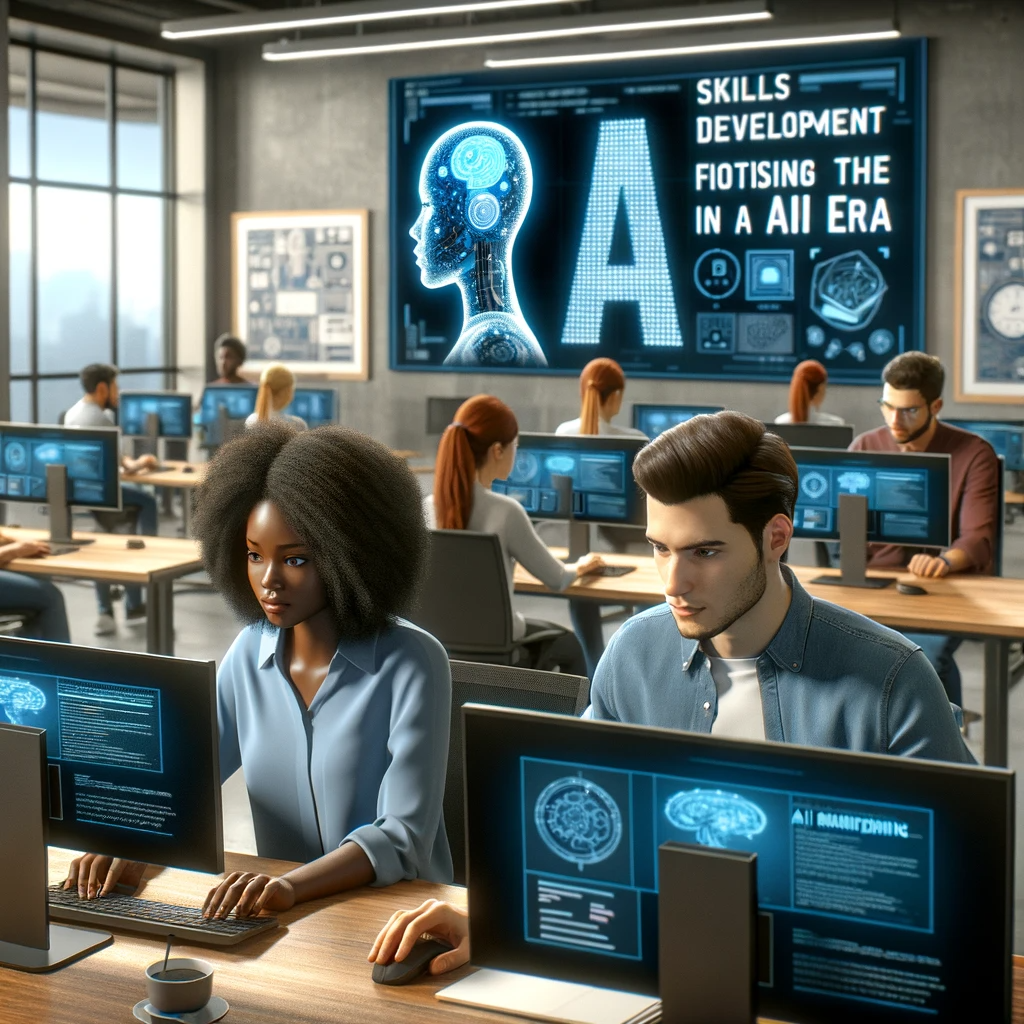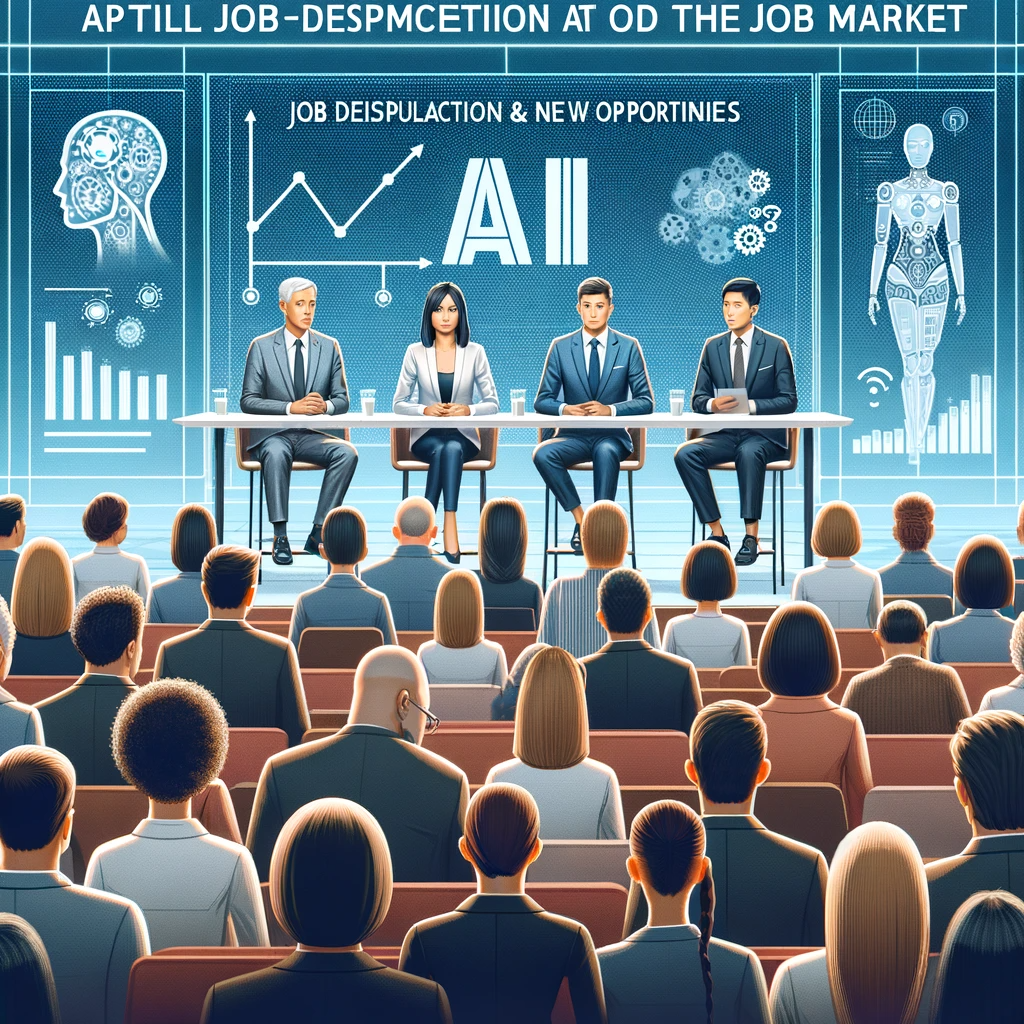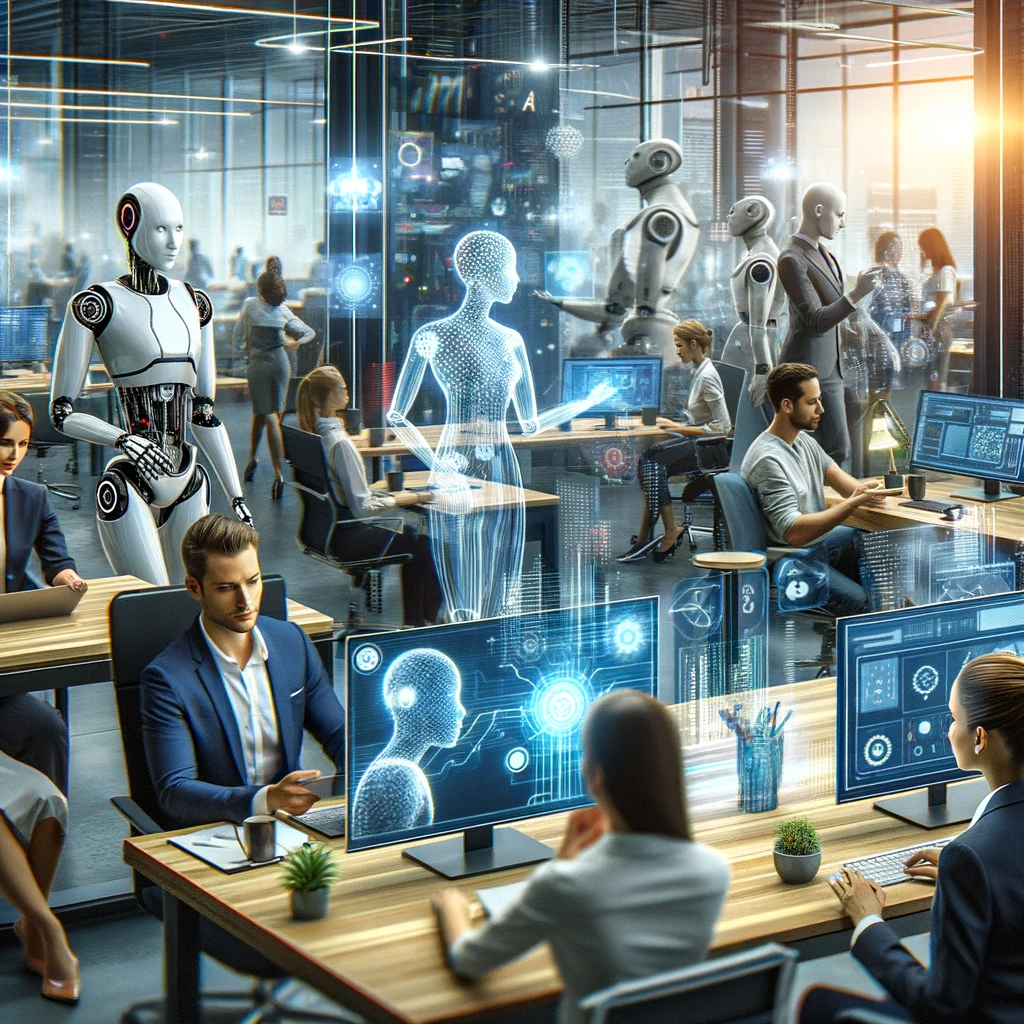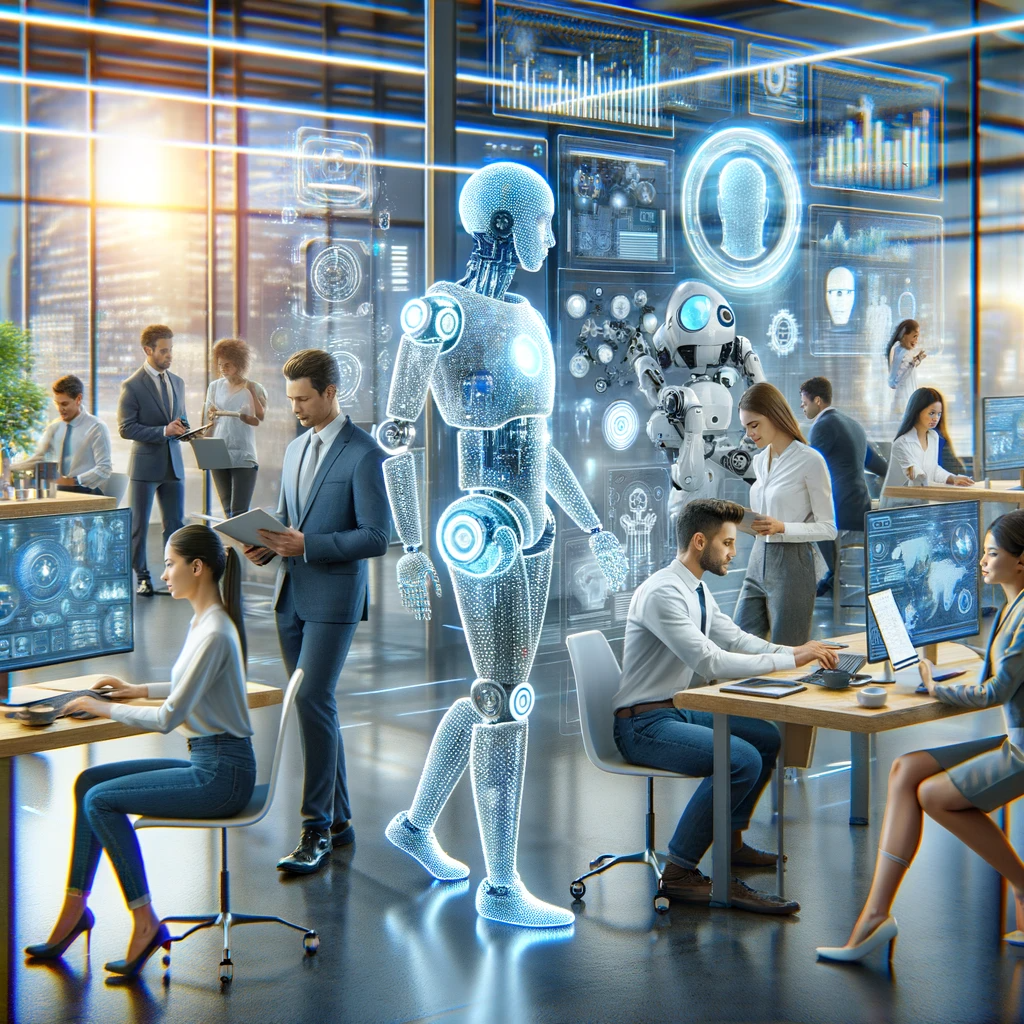In an era where technological advancements are reshaping the contours of our workspaces, the role of Artificial Intelligence (AI) has become a focal point of discussion. As AI systems grow increasingly sophisticated, they are not only automating routine tasks but also encroaching upon domains once thought exclusive to human intellect. This burgeoning influence of AI ignites a critical debate: Will AI ultimately usurp human jobs, leading to widespread unemployment, or will it forge new opportunities, spawning careers that we have yet to envision?
This dichotomy forms the crux of our exploration. While some envision a future where machines render human labor obsolete, others foresee a transformed landscape brimming with novel vocations, driven and enhanced by AI. Our article aims to delve into this ongoing debate, examining both sides of the coin. We will explore how AI has affected employment historically, the sectors most vulnerable to AI-induced displacement, and the emerging job categories birthed by AI innovation. Additionally, we will consider the role of education in preparing future workforces and address the ethical dimensions of this technological revolution. By weaving together expert insights, real-world examples, and predictive analyses, this article seeks to provide a comprehensive overview of AI’s paradoxical potential to both displace and create jobs in the modern world.

The Rise of Artificial Intelligence
The advent of Artificial Intelligence (AI) marks a revolutionary stride in technological advancement, reshaping the landscape of multiple industries. Its inception dates back to the mid-20th century, with gradual evolution from basic computational algorithms to today’s sophisticated machine learning models. AI’s integration has been profound and pervasive, influencing sectors from healthcare to finance, manufacturing to customer service.
In healthcare, AI algorithms assist in diagnosing diseases, predicting patient outcomes, and personalizing treatments. Finance has witnessed the advent of robo-advisors for investment strategies, and fraud detection systems powered by AI. Manufacturing industries employ AI for optimizing supply chains and predictive maintenance of machinery. Customer service has been transformed by AI-driven chatbots and virtual assistants, enhancing user experience while reducing human workload.
These examples represent just a fraction of AI’s current applications. Its potential for growth is exponential. Advancements in deep learning, natural language processing, and neural networks are pushing the boundaries of AI’s capabilities, paving the way for more autonomous, intelligent systems.
Future projections suggest a landscape where AI becomes integral to daily operations across all sectors. This includes potential breakthroughs in fields like autonomous vehicles, advanced
robotics, and AI in education, offering personalized learning experiences. However, with such growth comes complexity and the need for robust ethical frameworks and regulations to guide AI’s development and integration into society. This duality of vast potential coupled with significant challenges underlines the importance of understanding AI’s trajectory in the context of employment and societal impact.
The Case for Job Displacement
The narrative of technology reshaping the job market is not new. Throughout history, technological advancements have both displaced old jobs and created new ones. The Industrial Revolution, for instance, saw a significant shift from artisanal crafts to factory-based production, leading to the loss of many traditional jobs. Today, Artificial Intelligence (AI) represents a similar, albeit more complex, inflection point.
AI and automation pose a significant threat to jobs characterized by routine and predictability. Sectors like manufacturing, which has historically experienced job displacement due to automation, continue to be at risk. Here, AI-driven robots can perform repetitive tasks more efficiently and without the fatigue or injury risks associated with human labor. In customer service, AI chatbots and virtual assistants are increasingly handling tasks once performed by human operators, such as answering queries and managing appointments. The transportation sector also faces potential upheaval with the advent of autonomous vehicles, which could displace millions of driving jobs.
Recent years have witnessed several instances of AI replacing human jobs. In retail, self-checkout systems and online shopping algorithms have reduced the need for cashiers and sales associates. In finance, AI algorithms now perform stock trading and risk assessment tasks, roles traditionally held by financial analysts. Even in journalism, AI programs are being used to write simple news reports and financial summaries.
Industry experts and economists offer varying perspectives on this trend. Some argue that AI-induced job displacement is an inevitable part of technological progress, leading to a more efficient and productive economy. They contend that while some jobs disappear, new ones emerge in their wake, often in the same sectors affected by automation. For instance, while AI may reduce the need for certain manufacturing jobs, it also creates demand for AI specialists and technicians to maintain and improve these systems.
However, other experts express concern over the pace and scale of AI-driven job displacement. They warn that the rate at which new jobs are created may not match the speed of job losses, leading to significant economic and social challenges. These concerns are particularly pronounced in regions heavily reliant on industries vulnerable to automation.
In conclusion, while AI presents opportunities for increased efficiency and innovation, its impact on the job market is a complex issue, marked by the potential for significant job displacement in several sectors. The perspectives of industry experts and economists highlight the need for proactive measures to manage this transition, ensuring that the benefits of AI are balanced with the protection and evolution of the workforce.
The Counterargument – AI as a Job Creator
While the fear of job displacement due to Artificial Intelligence (AI) looms large, there’s a compelling counterargument: AI as a catalyst for job creation. This perspective highlights the emergence of new job categories and opportunities, stemming directly from AI’s integration into various sectors.
AI’s proliferation has led to the creation of specialized roles such as AI and machine learning engineers, data scientists, and AI ethics compliance managers. These roles focus on developing, managing, and ethically implementing AI systems. Beyond technical positions, there is a growing demand for professionals with expertise in AI applications specific to different industries, like healthcare diagnostics, financial analysis, and digital marketing.
A notable case study is the healthcare industry. The integration of AI in healthcare has not only improved efficiency but also created new roles. For instance, AI-assisted diagnostic tools require skilled professionals for development, maintenance, and interpretation of results. Similarly, in the automotive sector, the advent of autonomous vehicles has spurred growth in jobs related to AI-based navigation systems, safety features, and vehicle-to-vehicle communication technologies.
Moreover, there are roles and skills that AI is unlikely to replace. These include jobs requiring complex human emotions and empathy, like nursing, counseling, and teaching. Creative professions such as art, literature, and design also benefit from AI but are unlikely to be entirely replaced due to the intrinsic human creativity and subjective judgment they require.
Tech leaders and workforce analysts present an optimistic view of AI as a job creator. They argue that AI can enhance human capabilities and productivity, leading to the creation of higher-quality and higher-paying jobs. They also emphasize the importance of AI in solving complex global challenges, which in turn creates opportunities in research, development, and implementation of AI solutions.
However, they also caution that realizing these opportunities requires a proactive approach in workforce development. Upskilling and reskilling are crucial for workers to adapt to the changing job landscape. Emphasis on education and training programs that focus on AI and digital literacy can help prepare the current and future workforce for the evolving demands of an AI-driven economy.
In conclusion, while AI presents challenges in terms of job displacement, it also opens up a realm of new opportunities and roles. The key lies in leveraging AI’s potential to augment human work and in preparing the workforce through education and training to embrace the new job landscape shaped by AI.

The Role of Education and Training
In the face of the transformative impact of Artificial Intelligence (AI) on the job market, the role of education and training becomes paramount. Reskilling and upskilling the workforce are essential strategies to bridge the gap between current job skills and those demanded by an AI-driven economy. This adaptation not only helps workers stay relevant in their fields but also equips them to seize new opportunities created by AI advancements.
The education system is increasingly responding to the rise of AI by integrating digital literacy and AI-specific curricula. Schools and universities are introducing courses in data science, machine learning, and AI ethics, reflecting the skills needed in a technology-oriented job market. These programs are designed to provide students with a strong foundation in AI concepts, preparing them for careers in various sectors impacted by AI.
Governments and private sectors are collaborating to facilitate workforce training initiatives. Governments are launching programs and policies to support lifelong learning and continuous professional development. For instance, some countries have introduced national upskilling schemes, offering subsidies or tax incentives for AI-related education and training. Private sector companies, recognizing the need for a skilled workforce, are investing in training programs for their employees. These programs often focus on developing AI-related skills, ensuring that their workforce can effectively work with and alongside AI technologies.
Success stories from retrained workers in AI-impacted industries illustrate the effectiveness of these initiatives. For example, manufacturing workers who received training in robotics and AI system maintenance have transitioned into roles overseeing automated processes. In the finance sector, professionals trained in AI and data analytics are moving into new positions that involve interpreting AI-generated insights for strategic decision-making. These examples underscore the potential for education and training to not only mitigate job displacement but also to enhance career prospects and job satisfaction.
Education and training play a critical role in preparing the workforce for an AI-driven future. By emphasizing reskilling and upskilling, the education system, along with government and private sector initiatives, can create pathways for individuals to adapt and thrive in new career landscapes shaped by AI. These efforts are vital for ensuring that the workforce is not left behind in the rapidly evolving technological world.
Ethical Considerations and Social Impact
The integration of Artificial Intelligence (AI) in the workforce is not just an economic or technological issue but also a deeply ethical one, with significant social implications. The ethical debate around AI and employment centers on concerns such as fairness, transparency, and the broader societal impact of rapidly advancing technology.
One of the primary ethical concerns is the potential for AI to exacerbate inequalities. Job losses due to automation could disproportionately affect lower-wage, less-skilled workers, widening the existing socio-economic divide. This scenario raises questions about the equitable distribution of AI’s benefits and responsibilities, especially as some sectors and demographics might be more vulnerable to displacement than others.
The social impact of AI-induced job losses extends beyond economic factors, encompassing psychological and cultural dimensions. Employment is not just a source of income but also of identity, purpose, and community. The loss of jobs to AI can lead to social unrest, a decline in mental health, and a disruption of community structures, particularly in areas heavily reliant on industries susceptible to automation.
AI developers and corporations hold a significant responsibility in this context. Ethical AI development requires a commitment to creating systems that are not only efficient but also socially responsible. This involves considering the long-term impact of AI on employment and ensuring that AI systems are designed and implemented in ways that support human workers rather than simply replacing them. Transparency in AI algorithms, proactive engagement with stakeholders, and adherence to ethical guidelines are crucial components of responsible AI development.
Balancing technological advancement with social welfare is a complex but essential task. It calls for a collaborative approach involving governments, businesses, educational institutions, and civil society. Policies and regulations can play a vital role in guiding AI development towards beneficial outcomes, such as setting standards for ethical AI, providing safety nets for displaced workers, and encouraging investment in areas that can generate new employment opportunities. Education and training programs are key to equipping individuals with the skills needed in an AI-driven job market.
In summary, the ethical considerations and social impact of AI on employment demand thoughtful and concerted efforts from various sectors. It is crucial to navigate the advancement of AI not just with an eye towards economic growth and technological innovation, but also with a commitment to social equity and welfare.
Future Outlook and Predictions
As we venture deeper into the AI era, predictions about the future job market are a blend of optimism and caution. Experts generally agree that AI will continue to evolve, significantly altering the employment landscape. While some jobs will be automated away, new ones will emerge, often in fields we have yet to fully imagine. The consensus is that jobs requiring complex problem-solving, creativity, and emotional intelligence will be more resilient, whereas routine, repetitive tasks are more susceptible to automation.
One of the critical aspects of navigating this transition is the implementation of regulations and policies. Governments worldwide are expected to play a pivotal role in managing AI’s impact. This could involve setting standards for ethical AI development, ensuring fair labor practices in an increasingly automated economy, and providing safety nets for workers displaced by AI. Policies encouraging lifelong learning and facilitating workforce transitions through upskilling and reskilling initiatives will be essential. Additionally, there might be a move towards more stringent data privacy regulations, given AI’s reliance on large data sets.
The long-term implications for society and the global economy are profound. Economically, AI has the potential to drive significant growth, increase productivity, and create wealth. However, this growth might be unevenly distributed, posing challenges in terms of income inequality and economic disparity both within and between countries. Societally, the integration of AI could lead to major shifts in work-life balance, with the potential to redefine concepts of work, leisure, and productivity.

Conclusion
In this exploration of AI’s impact on employment, we’ve navigated a landscape marked by contrasts and complexities. AI’s rise heralds a significant technological evolution, impacting industries through both job displacement and the creation of new opportunities. Historical parallels remind us that while automation brings efficiency, it also poses threats to traditional jobs, particularly in sectors like manufacturing, transportation, and customer service. However, AI’s narrative isn’t solely one of job loss; it’s also about the birth of new roles and sectors, emphasizing the need for specialized skills in AI management and ethical application.
The role of education and training emerges as a cornerstone, vital for equipping the workforce with the necessary skills to thrive in an AI-driven future. Ethical considerations and the social impact of AI compel a balanced approach, integrating technological advancement with a commitment to social welfare and equitable growth.
As we stand at this crossroads, the future of work in the AI era remains a canvas of immense potential, yet to be fully painted. Will we steer this technological wave to augment human capabilities and create a more inclusive and prosperous society, or will we witness a widening of the socio-economic divide? The answers lie in our collective actions today, shaping a future where AI is not a harbinger of job loss but a catalyst for innovative and meaningful employment.
